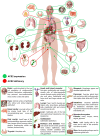Body Localization of ACE-2: On the Trail of the Keyhole of SARS-CoV-2
- PMID: 33344479
- PMCID: PMC7744810
- DOI: 10.3389/fmed.2020.594495
Body Localization of ACE-2: On the Trail of the Keyhole of SARS-CoV-2
Abstract
The explosion of the new coronavirus (SARS-CoV-2) pandemic has brought the role of the angiotensin converting enzyme 2 (ACE2) back into the scientific limelight. Since SARS-CoV-2 must bind the ACE2 for entering the host cells in humans, its expression and body localization are critical to track the potential target organ of this infection and to outline disease progression and clinical outcomes. Here, we mapped the physiological body distribution, expression, and activities of ACE2 and discussed its potential correlations and mutal interactions with the disparate symptoms present in SARS-CoV-2 patients at the level of different organs. We highlighted that despite during SARS-CoV-2 infection ACE2-expressing organs may become direct targets, leading to severe pathological manifestations, and subsequent multiple organ failures, the exact mechanism and the potential interactions through which ACE2 acts in these organs is still heavily debated. Further scientific efforts, also considering a personalized approach aimed to consider specific patient differences in the mutual interactions ACE2-SARS-CoV-2 and the long-term health effects associated with COVID-19 are currently mandatory.
Keywords: ACE2; ACE2 receptor; COVID-19; SARS-CoV-2; body localization.
Copyright © 2020 Salamanna, Maglio, Landini and Fini.
Conflict of interest statement
The authors declare that the research was conducted in the absence of any commercial or financial relationships that could be construed as a potential conflict of interest.
Figures

References
Publication types
LinkOut - more resources
Full Text Sources
Miscellaneous

